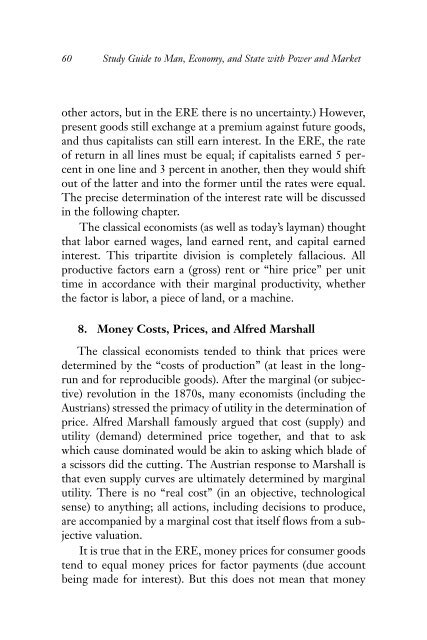Study Guide to Man, Economy, and State with Power and Market
Study Guide to Man, Economy, and State with Power and Market
Study Guide to Man, Economy, and State with Power and Market
Create successful ePaper yourself
Turn your PDF publications into a flip-book with our unique Google optimized e-Paper software.
60 <strong>Study</strong> <strong>Guide</strong> <strong>to</strong> <strong>Man</strong>, <strong>Economy</strong>, <strong>and</strong> <strong>State</strong> <strong>with</strong> <strong>Power</strong> <strong>and</strong> <strong>Market</strong><br />
other ac<strong>to</strong>rs, but in the ERE there is no uncertainty.) However,<br />
present goods still exchange at a premium against future goods,<br />
<strong>and</strong> thus capitalists can still earn interest. In the ERE, the rate<br />
of return in all lines must be equal; if capitalists earned 5 percent<br />
in one line <strong>and</strong> 3 percent in another, then they would shift<br />
out of the latter <strong>and</strong> in<strong>to</strong> the former until the rates were equal.<br />
The precise determination of the interest rate will be discussed<br />
in the following chapter.<br />
The classical economists (as well as <strong>to</strong>day’s layman) thought<br />
that labor earned wages, l<strong>and</strong> earned rent, <strong>and</strong> capital earned<br />
interest. This tripartite division is completely fallacious. All<br />
productive fac<strong>to</strong>rs earn a (gross) rent or “hire price” per unit<br />
time in accordance <strong>with</strong> their marginal productivity, whether<br />
the fac<strong>to</strong>r is labor, a piece of l<strong>and</strong>, or a machine.<br />
8. Money Costs, Prices, <strong>and</strong> Alfred Marshall<br />
The classical economists tended <strong>to</strong> think that prices were<br />
determined by the “costs of production” (at least in the longrun<br />
<strong>and</strong> for reproducible goods). After the marginal (or subjective)<br />
revolution in the 1870s, many economists (including the<br />
Austrians) stressed the primacy of utility in the determination of<br />
price. Alfred Marshall famously argued that cost (supply) <strong>and</strong><br />
utility (dem<strong>and</strong>) determined price <strong>to</strong>gether, <strong>and</strong> that <strong>to</strong> ask<br />
which cause dominated would be akin <strong>to</strong> asking which blade of<br />
a scissors did the cutting. The Austrian response <strong>to</strong> Marshall is<br />
that even supply curves are ultimately determined by marginal<br />
utility. There is no “real cost” (in an objective, technological<br />
sense) <strong>to</strong> anything; all actions, including decisions <strong>to</strong> produce,<br />
are accompanied by a marginal cost that itself flows from a subjective<br />
valuation.<br />
It is true that in the ERE, money prices for consumer goods<br />
tend <strong>to</strong> equal money prices for fac<strong>to</strong>r payments (due account<br />
being made for interest). But this does not mean that money

















